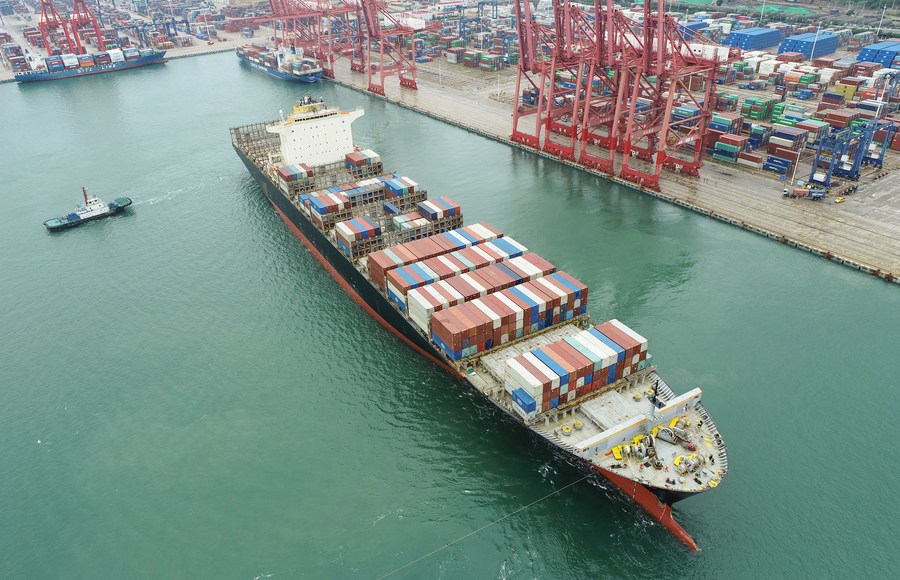Busy container ports herald China's robust foreign trade

A ship loaded with cargoes leaves a container terminal in Lianyungang, east China's Jiangsu Province, July 13, 2021. [Photo by Wang Jianmin/Xinhua]
BEIJING -- China's container shipping sector registered steadfast growth this year amid headwinds from the COVID-19 pandemic and container shortages, indicating the country's robust foreign trade and economic resilience.
Cargo throughput at China's ports totaled 12.87 billion tonnes in the first 10 months, up 7.8 percent year on year. During the period, container throughput reached 235 million twenty-foot equivalent units (TEUs), expanding by 8.4 percent from a year earlier.
As domestic ports have been bustling with containers, China's foreign trade in the first 11 months surged 22 percent year on year to 35.39 trillion yuan (about 5.56 trillion U.S. dollars), customs data showed.
The figure, already surpassing the 32.16-trillion-yuan total for all of 2020, marked a 24 percent increase from the pre-pandemic level in 2019.
Effective epidemic prevention and control measures adopted by the Chinese government contributed significantly to stabilizing industrial chains, boosting the overseas shipping orders of Chinese companies.
Praising the successful implementation of China's epidemic-prevention strategy, chairman of China's state-owned shipping giant China COSCO Shipping Corporation Limited (COSCO Shipping) Wan Min said the company handled around 22.45 million TEUs of containers in the first 10 months, representing year-on-year growth of 5.7 percent.
"China's potent epidemic-containment efforts and fast resumption of work and production accelerated the growth of demand for cargo transportation, and brought about hope for global shipping companies," said Liu Wen, assistant general manager of the Shanghai branch of Singapore-based Pacific International Lines (PTE) Ltd.
Most of the company's vessels were dispatched to operate in the Chinese market, Liu added.
When the container shortage hampered China's container shipping industry, government organs and businesses adopted multiple measures to boost supply and ensure the smooth flow of goods.
Under coordinated government actions led by the Ministry of Transport, shipping giant COSCO Shipping transported 13,469 empty containers back to domestic ports in March, quenching the country's container thirst.
The supply of new containers has also been boosted by container manufacturers accelerating production. In September, the monthly container production capacity in China surged from 200,000 TEUs to a record high of 500,000 TEUs, official data showed.
The constant introduction of favorable policies also propelled China's foreign trade growth. The business environment has been optimized with a slew of reform measures including facilitating cross-border trade and promoting trade and investment in pilot free trade zones.
This has not only boosted the confidence of market players, but also helped to further strengthen China's opening up, said Bai Ming, a researcher with the Chinese Academy of International Trade and Economic Cooperation under the Ministry of Commerce.
In the country's southern island province Hainan, an international maritime transport and trade hub is taking shape in Yangpu Port, with favorable measures targeted at investment, administrative approvals and financial support for small and micro-sized firms attracting more and more foreign trade companies to the area.
"The favorable policies in the Hainan free trade port, especially the value-added processing policy first implemented in the Yangpu free trade port area, have given us incredible business opportunities," said Zhang Hui, general manager of an international food company.
























